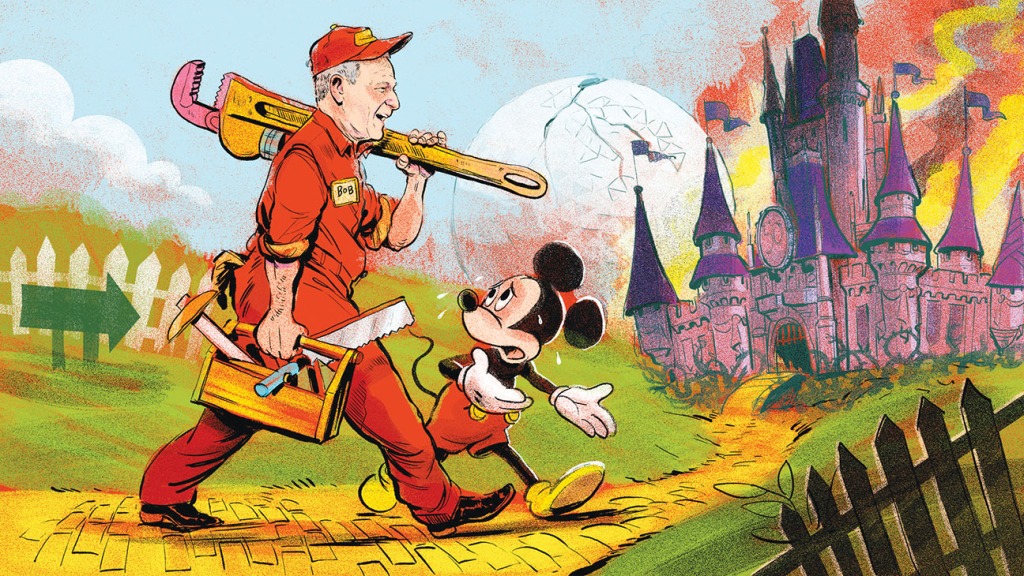
When Bob Iger returned to Disney’s Burbank lot on Nov. 28, clad in a bright white shirt and a blue cardigan, he sought to reassure anxious employees by quoting Hamilton, Lin-Manuel Miranda’s Tony-winning musical. “There is no more status quo … But the sun comes up and the world still spins,” actor Daveed Diggs sang as Thomas Jefferson in the original production. “That’s how I feel here. The status quo is gone,” Iger told assembled Disney employees. “A lot has changed, but the sun is still shining, and our Disney world is still spinning.”
Iger’s triumphant return to Disney after Bob Chapek’s ouster is complicated by a troubled macroeconomic environment, and the incoming CEO acknowledged that austerity would be in order at the company. And there’s also the matter of the ticking clock, with Disney’s board giving Iger two years to point the company in the right direction and find a worthy successor — who sticks. Inside Disney, the excitement from the employees at the town hall for Iger’s return was palpable. Two employees who watched remotely tell The Hollywood Reporter that Iger was reassuring, giving the presence of a steady hand during unsteady times.
If one wants to understand what Iger must have been feeling, watching from the sidelines over the past year as Disney stumbled from misstep to misstep while its stock price fell about 40 percent year-to-date, you would need only to read the prologue to his 2019 leadership tome, The Ride of a Lifetime. “I tend to approach bad news as a problem that can be worked through and solved, something I have control over rather than something happening to me,” he wrote.
“I do believe that the past can be a beacon to light a path to the future,” Iger told Disney employees during the town hall. So it makes sense to note that his first shake-up since returning to Disney bears an eerie similarity to the very first move he made after being named Michael Eisner’s successor in 2005. Under Eisner “virtually all noncreative decisions were made by the central oversight group [called Strategic Planning],” Iger recalled in his memoir. The problem? “The centralized decision making had a demoralizing effect on the senior leaders of our businesses, who sensed that the power to run their divisions really resided at Strategic Planning,” Iger wrote. “The other was that their overly analytical decision-making processes could be painstaking and slow.”
So Iger dramatically restructured the group, and handed power back to the creative divisions. He wrote in the book that it was the “most significant accomplishment” of those early months. “The announcement that they would no longer have such an iron grip on all aspects of our business had a powerful, instantaneous effect on morale,” the executive added. “It was as if all the windows had been thrown open and fresh air was suddenly moving through.”
Seventeen years later and Iger is surely hoping that the fresh air is once again flowing through the halls in Burbank, as yet another centralized structure bites the dust.
On the sidelines, Iger was a bystander (albeit a bystander with a great deal of his net worth tied up in Disney stock), watching as his handpicked successor, who he hoped was prepared for the worst, stumbled. Back in the CEO seat, Iger can reassert control. But if he felt he left the company last time with a winning hand, now he has to start from scratch. “Iger has a lot of work to do. The company hasn’t been a well-run machine, and Bob is coming in to reenergize and improve profitability,” says a veteran Hollywood source.
Ousting Kareem Daniel and unveiling plans to reorganize his Disney Media and Entertainment Distribution group left some in Hollywood thinking that he was returning to the pre-COVID norms. Such a move would be welcomed inside the company. A Disney source had griped to THR weeks before Chapek’s Nov. 20 departure that the creation of DMED slowed down the process for deciding where certain content would be the best fit. And the 2020 Chapek-led reorganization led to significant layoffs and changed responsibilities. Any effort to reverse course, even in part, will take time.
But that doesn’t mean changes won’t be made, and fast. “With Daniel out of the way, we believe that Iger may return P&L responsibilities to division heads from the centralized model under Daniel,” Morningstar senior equity analyst Neil Macker wrote in a Nov. 21 note.
Indeed, in the company’s annual report, which it filed with the SEC on Nov. 29, Disney said that it expects changes to come, and impairment charges to follow.
“While the plans are in early stages, changes in our structure and operations, including within DMED (and including possibly our distribution approach and the businesses/distribution platforms selected for the initial distribution of content), can be expected,” the filing states. “The restructuring and change in business strategy, once determined, could result in impairment charges.”
If P&L is returned to the content divisions, each will need staff to account for their respective finances, something that is now centralized in DMED, and from a technical and legal standpoint, Disney will need to change how it reports earnings to investors.
Some analysts argue that Chapek’s reorganization also made much-needed changes for a streaming-first age. While streaming revenue increased 8 percent to $4.9 billion in its latest quarter, losses ballooned by more than 100 percent to $1.5 billion. Iger’s plan to enhance streaming profits is, for now, about as detailed as Chapek’s. The Disney+ ad-supported tier is certainly part of it, but finding places to cut costs amid an ongoing battle for content will be challenging. Perhaps Disney takes a cue from Warner Bros. Discovery and sends fewer films directly to streaming, hoping to recoup more cash from theatrical distribution.
But streaming is unlikely to be Iger’s only focus. Chapek’s “heavy emphasis on raising prices across the organization,” such as at Disney’s theme parks, is likely to be another area “where Iger deviates,” wrote Bank of America’s Jessica Reif Ehrlich on Nov. 21. With demand for theme parks and experiences so high, Chapek responded by raising prices but also adding upcharges like Genie+ and Lightning Lane (which allow parkgoers to skip long lines), features that had previously been free. While strong demand can sustain higher prices, it can come at the expense of brand equity, something near and dear to Iger’s heart. In a stark contrast to streaming losses, revenue at Disney’s domestic parks segment (now run by Josh D’Amaro) rose by 44 percent year-over-year to $5 billion, while operating profits soared by more than 100 percent to $741 million. But an employee in the parks division (Chapek’s division before being made CEO) says morale has been low in that unit. “The reaction [to Iger returning] has been universal joy and excitement from everyone,” this source adds.
The board mandate to Iger to focus on overarching strategy, structure and succession, and his limited two-year deal, may keep him more focused on high-level operations rather than the minutiae of Disneyland’s Dole Whip prices or cruise ship entertainment options. And while Chapek’s plan to launch a “cost structure task force” may be on hold, Disney will need to find places to cut costs, much like every other media and tech company. (Iger plans to keep Chapek’s hiring freeze and travel reduction rules in place.)
In early September, Iger issued a dire warning for the industry. Linear television, which for 30 years has formed the economic backbone of Hollywood, “is marching to a great precipice,” he said, “and it’s going to be pushed off.” For linear’s slow decline and other issues, there’s “no ‘quick fix’ for Disney in the months ahead,” LightShed analyst Rich Greenfield noted Nov. 22.
But after the initial Iger glow wears off, the reality is that his return is all but assured to be short-lived, with the board tasking him with finding a successor. And while there are internal candidates like TV entertainment chief Dana Walden, ESPN and sports head Jimmy Pitaro, and international chief Rebecca Campbell, Iger may also very well look outside the company, perhaps to a veteran entertainment executive (bring back Peter Rice?) or a more outside-the-box pick (former Meta COO Sheryl Sandberg was in the mix last time).
Hamilton, which Iger is clearly fond of, leans into the complexity of legacy (“Who lives, who dies, who tells your story?” is the tagline, after all). His return to Disney may have sparked exuberance from staff, but it will also be an opportunity for him to give his professional legacy a do-over.
Kim Masters and Pamela McClintock contributed to this report.
This story first appeared in the Nov. 30 issue of The Hollywood Reporter magazine. Click here to subscribe.

